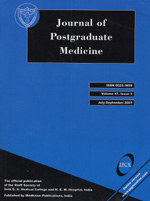
|
Journal of Postgraduate Medicine
Medknow Publications and Staff Society of Seth GS Medical College and KEM Hospital, Mumbai, India
ISSN: 0022-3859
EISSN: 0022-3859
Vol. 49, No. 3, 2003, pp. 214-217
|
 Bioline Code: jp03061
Bioline Code: jp03061
Full paper language: English
Document type: Research Article
Document available free of charge
|
|
|
Journal of Postgraduate Medicine, Vol. 49, No. 3, 2003, pp. 214-217
| en |
Duodenal Tuberculosis: Radiological Features on Barium Studies and their Clinical Correlation in 28 Cases
Chavhan GE, Ramakantan R
Abstract
BACKGROUND: A retrospective analysis of 28 cases of duodenal tuberculosis (TB) was done to evaluate radiological findings and their value in the diagnosis of the disease. subjects AND METHODS: Upper gastrointestinal and small bowel series of 28 patients with duodenal tuberculosis were analysed for radiological findings. The diagnosis of duodenal TB was confirmed by surgery and biopsy in 18, on the basis of radiological findings and response to treatment in 9, and on the basis of findings on upper gastrointestinal scopy and biopsy in 1 patient. RESULTS: The study included 28 patients (14 males, 14 females). The mean age was 32.1 (range 5-65). Twenty-three (82.2%) patients presented with obstructive symptoms while five manifested with dyspeptic symptoms. Of the latter, 4 had ulcerations in the third and fourth parts of the duodenum. In the remaining patient, the mucosa of the duodenum could not be clearly visualised. Two patients had extrinsic impression at the D2-D3 and D3-D4 segments. In 23 patients with obstructive symptoms, 18 demonstrated luminal narrowing of varying degrees and 5 had a sharp band-like cut-off at the third part of the duodenum. Of the 18 patients with luminal narrowing, 13 had extrinsic compression, 12 had proximal dilatation and 14 had ulcerations mainly in the second and third parts of the duodenum. Biliary involvement was seen in 3 patients without any signs or symptoms directly referable to the biliary involvement. CONCLUSION: Though duodenal TB lacks specific radiological features, barium studies help to localise and define the area of narrowing and ulcerations and help to confirm the presence of lymph nodes causing compression of the duodenum.
|
| |
© Copyright 2003 Journal of Postgraduate Medicine. Online full text also at http://www.jpgmonline.com
Alternative site location: http://www.jpgmonline.com
|
|
